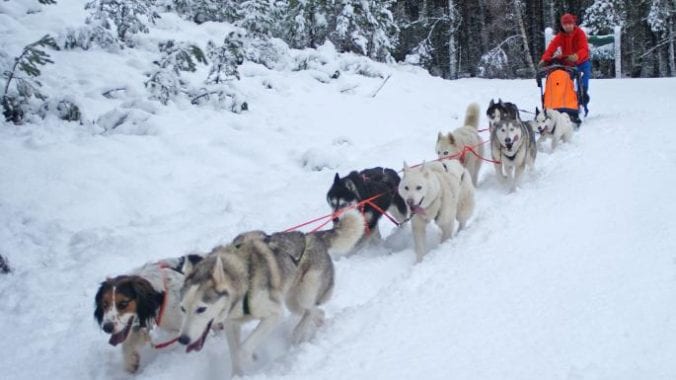Harry McArthur
The rules and equipment required for dog sledding are available at the bottom of the article, so if you are unsure on any of the technical terms used have a look down there!
I would have been shocked if a matter of weeks ago someone told me that they could blend together two of my favourite things in life. After some searching I found it; a combination of sports and dogs. Dog sledding. To find out more about dog sledding I caught up with the social media manager of the SDAS (Sled Dog Association of Scotland), Ashleigh Dean, for some details on the sport.
“Dog sledding is not one of the first sports you think of in Scotland or the UK, but over the last few years it has grown a lot. In many other countries, dog sled sports are recognized and for some countries it is part of their culture and history.
“Many people are under the impression that the sport is only done on a sled, on snow, for miles and miles, so can’t really be done in Britain. In Scotland we get a chance to do some of our training using a sled on snow, but the majority of our races are completed on a rig. In Britain we mostly focus on sprint distances. So speed more than mileage, as trails for distance are hard to come by.”
There are a large variety of dog sled sports, all of which include dogs pulling with a harness. There is dryland mushing (which includes teams of dogs pulling rigs) bikejor (which is one bike being pulled by one dog) scooter (which is a scooter being pulled by two dogs) and cani cross (which is one runner with one dog). The SDAS tend to focus on sprint racing, as it is hard to find, and be allowed access to, longer tracks.
As a dog lover, it was important to find out how dogs were treated, as there have been instances of show animals being manipulated in order to enhance their looks, or in other sports being physically struck for underperforming. Ashleigh however put any concerns to rest when she explained,
“The dogs love it! As soon as they are hooked up to the team, they are eager to get going, lunging into their harness. The dogs are the stars of the sport. They need to be treated like the athletes they are. They work hard and need a good diet and exercise regime, just like any human athlete. Each dog takes to training differently. Some may take to running in harness instantly and others may need more time or encouragement.
“It is important that all training is kept positive and fun. People will know their dogs and what they need. Some people may train their dogs twice a week others may train five times a week.”
Ashleigh continued, “Training is important but it has to be done carefully. Temperature and humidity is an important factor. If they are too high it can cause long lasting damage to a dog. There is a general rule some like to follow. If you take temp x humidity and it equals 1000 or under it is usually ok to train. Again each team should know what their dogs can cope with.”
Ashleigh then spoke about the impact the sport has on the relationship between dog and owner,
“I feel passionately about sled dog sports as it is great to see dogs and their owners work together. The bond between dog and driver can be strong and it is rewarding to see. It can be hard work but the rewards are worth it. It is an exciting sport.
“My team and I work hard and get good results. I have seen me win a race and be pleased but sometimes you can come second or last and be just as happy. It’s all about the run. If I feel the team worked hard and did their best I am happy. The sport can be brutal. Dogs like humans can get injuries or get ill. They are not equipment.”

Credit: Pinterest Dry-land mushing- when the trainer is on a cart and is pulled along by multiple dogs
She added, “When everything comes together it is amazing. I am proud of my dogs. We are a great team. I can’t imagine my life without dogs. I think people should take more of an interest in the sport.”
We then moved on to discuss the different types of dogs that were involved.
“At SDAS there is no restriction in breed that can enter. As long as the dog is willing to pull, wants to run and is safe to do so we welcome them. In our cani cross, bikejor and scooter class we see jack russels, spaniels and german shepherds. It is great. It allows everyone the opportunity to get out and get fit with their dog.
“Traditionally sled dogs were Nordic breeds. Dogs such as Siberian Huskies or malamutes. This was because of their strength and ability to survive in the freezing weather conditions. They were used for day to day life and surviving. As races began to develop, the main focus was not survival alone but also on speed. Breeds such as the Alaskan husky became more popular. Since then the sport has continued to develop. Today in sprint races you can see a variety of different dog breeds and mixes: Eurohounds, Scandinavian hound, huskies, Greysters, German pointers and more.”
With the sport consistently growing in the past few years, the best time to get involved is now. The SDAS are very keen to see participation, whether it be partaking in dog sledding, or coming along and watching.
“There is a lot to look forward to at SDAS as our race season has just started. This year we have 12 championship races over six weekends and are also hosting the Scottish BSSF qualifier race. Our SDAS race series has some fantastic venues all over Scotland and as we have some southern members we have also put on some races in England so they don’t have to travel.”
She continued, “People can easily get involved or want to follow the sport get in touch with an organisation, attend a local event and see what it is all about or go on line and look for your local group and ask for advice. Cani cross or bikejor is a great place to start as you can do it with one dog. Look on our website for upcoming events or for local groups and equipment stockists.”
If you are interested in getting involved you can find links to various websites below.
www.uk9sleddogsportscentre.co.uk
SDAS competitive dog sledding rules:
Sprint racing- the teams are faced with a challenging course that they need to get around. The fastest time wins! The teams are set off in intervals, following markers around the trail. Round red markers tell the musher what turns to take, blue is a straight on or a confirmation and yellow triangle is a caution. The musher guides the dogs by using the terms gee for right and haw for left.
Race distances are similar to our usual races, if possible eight and six dog teams can run from 5km to ideally something near 8km, but it is hard to find forests or private estates that have or allow us to use the trails. The two and four dog class, cani cross, bikejor and scooter will be around 5km, with juniors doing around 3 km. When SDAS pick a trail for an event we look for a few key points:
- Quality of trail surface. The trail must be safe for dogs running at speed. Level grassy trails or smooth forestry roads are ideal; we tend to stay clear of tarmac or trails with ruff surfaces as this can cause injury to dog’s pads, or joints.
- Exciting. We like to choose trails that keep human and dog excited. Twists, turns, hills are all part of a great trail.
- Location. We try to spread our race venues as best we can. This allows our members to be able to attend at least one race if travel is difficult for them.
Equipment used for dog sledding:
For the dogs:
Harness: There are a few types but one of the most popular would be the x back harness.It allows the dogs to move freely and get an effective pull. At the bottom of the harness is a tug, a loop of cord that allows the dog to be attached to the gangline or bungee line.
For Teams:
Rig: A rig will be needed. This is where the musher stands and the team are attached to. The rig can have three or four wheels. It must have brakes, preferably on all wheels!
Gangline/towline: This is the line that attaches the dogs to the rig. There is a shock absorber at the bottom that is attached to the rig. This reduces any jerky movement. The gangline runs up the middle of the team,
Tug line: The tug line attaches the dog to the gangline, attaching at the tug on the harness.
Neckline: This keeps the dogs in line. It attaches from the dogs collar to the gangline.
For bikejor/scooter:
A bike or scooter is obviously needed to start with but also:
Bikejor arm: usually made from a type of plastic the arm is attached to the bike and sticks out over the front wheel. This is to keep the bungee line from catching in the wheel.
Bungee line: Attaches to the bike, along the bikejor arm and onto the tug of the dogs harness. It reduces jerky movements between dog and bike.
Canicross:
Running belt/harness: This is a harness for the human! It sits low on the runners hips to allow for maximum pull. The harness attaches to a bungee line that attaches to the dog.






Leave a Reply